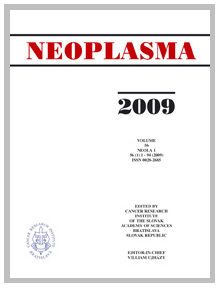Journal info
|
||
Select Journal
Journals
Bratislava Medical Journal Ekologia - Ecology Endocrine Regulations General Physiology and Biophysics Neoplasma 2025 Ahead of print 2024 2023 2022 2021 2020 2019 2018 2016 2017 2015 2014 2013 2012 2011 2010 2009 2008 2007 2006 2005 2004 2003 Acta Virologica Studia Psychologica Cardiology Letters Psychológia a patopsych. dieťaťa Kovove Materialy-Metallic Materials Slovenská hudba 2025Webshop Cart
Your Cart is currently empty.
Info: Your browser does not accept cookies. To put products into your cart and purchase them you need to enable cookies.
Neoplasma Vol.67, No.6, p.1437–1446, 2020 |
||
| Title: Association of quantitative MRI-based radiomic features with prognostic factors and recurrence rate in oropharyngeal squamous cell carcinoma | ||
| Author: C. GIANNITTO, G. MARVASO, F. BOTTA, S. RAIMONDI, D. ALTERIO, D. CIARDO, S. VOLPE, F. DE PIANO, E. ANCONA, M. TAGLIABUE, D. ORIGGI, S. CHIOCCA, F. A. MAFFINI, M. ANSARIN, V. BAGNARDI, F. CATTANI, F. NOLÈ, L. PREDA, R. ORECCHIA, E. CASSANO, M. CREMONESI, A. STARZYŃSKA, M. BELLOMI, B. A. JERECZEK-FOSSA | ||
| Abstract: Radiomics focuses on extracting a large number of quantitative imaging features and testing both their correlation with clinical characteristics and their prognostic and predictive values. We propose a radiomic approach using magnetic resonance imaging (MRI) to decode tumor phenotype and local recurrence in oropharyngeal squamous cell carcinoma (OPSCC). The contrast-enhanced T1-weighted sequences from baseline MRI examinations of OPSCC patients treated between 2008 and 2016 were retrospectively selected. Radiomic features were extracted using the IBEX software, and hierarchical clustering was applied to reduce features redundancy. The association of each radiomic feature with tumor grading and stage, HPV status, loco-regional recurrence within 2 years, considered as main endpoints, was assessed by univariate analysis and then corrected for multiple testing. Statistical analysis was performed with SAS/STAT® software. Thirty-two eligible cases were identified. For each patient, 1286 radiomic features were extracted, subsequently grouped into 16 clusters. Higher grading (G3 vs. G1/G2) was associated with lower values of GOH/65Percentile and GOH/85Percentile features (p = 0.04 and 0.01, respectively). Positive HPV status was associated with higher values of GOH/10Percentile (p = 0.03) and lower values of GOH/90Percentile (p = 0.03). Loco-regional recurrence within 2 years was associated with higher values of GLCM3/4-7Correlation (p = 0.04) and lower values of GLCM3/2-1InformationMeasureCorr1 (p = 0.04). Results lost the statistical significance after correction for multiple testing. T stage was significantly correlated with 9 features, 4 of which (GLCM25/180-4InformationMeasureCorr2, Shape/MeanBreadth, GLCM25/90-1InverseDiffMomentNorm and GLCM3/6-1InformationMeasureCorr1) retained statistical significance after False Discovery Rate correction. MRI-based radiomics is a feasible and promising approach for the prediction of tumor phenotype and local recurrence in OPSCC. Some radiomic features seem to be correlated with tumor characteristics and oncologic outcome however, larger collaborative studies are warranted in order to increase the statistical power and to obtain robust and validated results. |
||
| Keywords: radiomics; oropharyngeal squamous cell carcinoma; prognostic factors; Human Papilloma Virus (HPV) | ||
| Published online: 13-Aug-2020 | ||
| Year: 2020, Volume: 67, Issue: 6 | Page From: 1437, Page To: 1446 | |
| doi:10.4149/neo_2020_200310N249 |
||
|
|
 download file download file |
|

